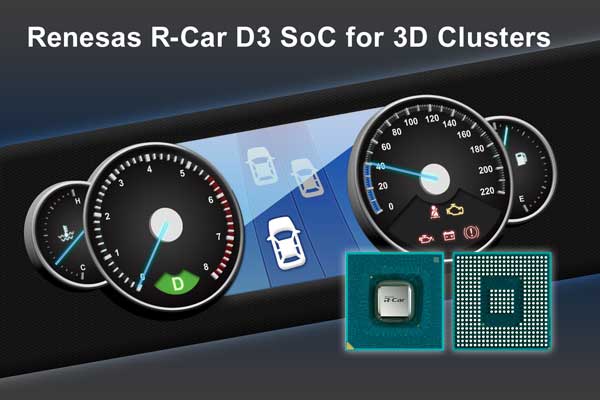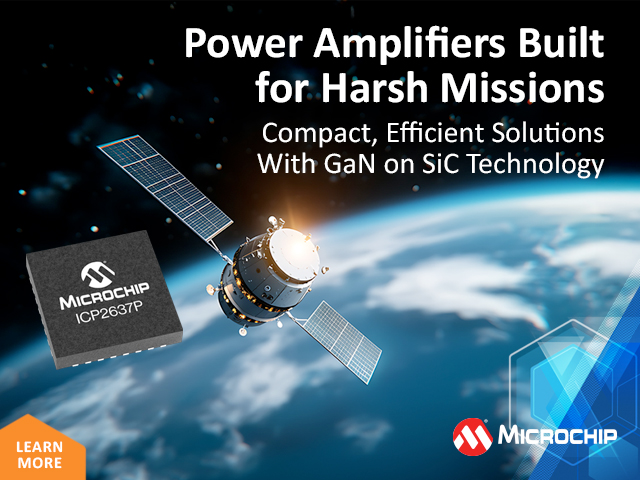 Renesas Electronics today announced its high-performance R-Car D3 automotive infotainment system system-on-chip (SoC), designed to expand the use of 3D graphics instrument clusters (3D clusters) that support 3D graphics displays in entry-class cars. The R-Car D3 achieves both high-performance graphic capabilities and contributes to significant reduction in overall system development cost. The new SoC includes a high-performance 3D graphics core that enables a high-quality 3D display and lower system costs equivalent to the bill of materials (BOM) costs of developing with 2D graphics instrument clusters (2D clusters).
Renesas Electronics today announced its high-performance R-Car D3 automotive infotainment system system-on-chip (SoC), designed to expand the use of 3D graphics instrument clusters (3D clusters) that support 3D graphics displays in entry-class cars. The R-Car D3 achieves both high-performance graphic capabilities and contributes to significant reduction in overall system development cost. The new SoC includes a high-performance 3D graphics core that enables a high-quality 3D display and lower system costs equivalent to the bill of materials (BOM) costs of developing with 2D graphics instrument clusters (2D clusters).
By adopting the R-Car D3, system developers can re-use their 3D graphics development assets, including software and graphics designs from high-end vehicles that adopt high-performance R-Car H3 or R-Car M3 SoCs to entry-level cars. This scalability enables development of easy-to-use and high visibility entry cluster 3D graphics at approximately the same level cost as the existing 2D clusters. In addition, Renesas collaborates with industry-leading partners in the instrument cluster field to further reduce development steps and costs. The increasing number of connections between the instrument cluster and the various sensors and control devices allows more information about the vehicle and its surroundings to be captured and displayed on the instrument cluster. However, this increases the need for improved visibility from a safety point of view.
Currently, entry-class vehicles feature mostly 7- to 10-inch liquid crystal displays (LCDs) that support mainly 2D graphics. In the future, advancements in automotive LCDs size, resolution, and prices will support an anticipated explosive demand in 3D clusters to meet the growing need for clearer and highly visible designs on a large screen, particularly in the Chinese market.
In the meantime, system developers working with automotive instrument clusters must manage an increasing number of development steps and costs, as 3D clusters for entry-class cars are required to meet both the strict cost and high-performance as existing 2D clusters but with 3D graphics drawing requirements.
Renesas developed the R-Car D3 with these functions and performance capabilities in mind, offering developers a reliable, robust 3D clusters solution that is scalable from entry-level to high-end vehicles.
Key features of the R-Car D3
- High-performance 3D graphics core that enables high-quality 3D display and lower system costs equivalent to that of 2D cluster development
The new SoC includes a 3D graphics core that enables high-performance human-machine interface (HMI) and realizes significantly reduced system development cost equivalent to those of existing 2D cluster systems.
3D graphics core that enables high-performance HMI
Leveraging one of the latest graphics cores from Imagination Technologies, Inc, the Power VR® Series 8XE, the R-Car D3 achieves approximately six times improved drawing performance compared to the existing 3D graphics R-Car D1 SoC. This allows system developers to reuse content created for high-end cars in entry class cars, system designers who had previously been concerned about hardware graphics performance limitations, can now create graphics content without concern or limitations.
Reduced system costs by approximately 40 percent compared to existing Renesas devices (Note 1)
The R-Car D3 adopts the ball grid array (BGA) package, which simplifies the use of printed circuit boards (PCBs). This allows system developers to create 3D clusters using low-cost, four-layer PCBs, reducing the system BOM costs. The Renesas R-Car D3 reference boards , also use four-layer PCBs, and Renesas provides the design data as reference data for system developers to simplify the design of their own systems. In addition, since the new SoC achieves industry-leading level of low power consumption (Note 1), developers can configure a power supply circuit using a relatively inexpensive discrete power supply regulator. Since a cluster system can be configured with one DDR SDRAM, it is possible to reduce BOM cost by approximately 40 percent (Note 1) compared with 3D cluster systems that include the existing R-Car D1, realizing the total system development cost equivalent to the existing 2D cluster. The automatic memory calibration function (Note 2) of the DDR SDRAM, which is standard in R-Car SoCs, eliminates the need for timing adjustment of data transfer with the SRAM and memory evaluation man-hours requirements.
- Robust partner ecosystem to streamline development steps
Renesas works with several operating system (OS) manufacturers, HMI manufacturers, and system integrators who are leading the instrument cluster field. System developers can take advantage of a wide range of automotive solutions by working with the more than 200 Renesas R-Car Consortium partner companies to further reduce the number of development steps and cost for 3D graphics. In addition, the R-Car D3 uses open GL ES 3.1 for 3D graphics drawing, which enables scalability with third-generation R-Car devices. Furthermore, the new SoC uses the same 2D graphics core as the RH850/D1M microcontroller (MCU) for 2D graphics applications. This assures that users will be able to reuse all their software assets and design content assets development from applications ranging from 2D clusters to high-end 3D clusters. As part of the third-generation R-Car SoC Family, the R-Car D3 supports the ISO 26262 (ASIL-B) automotive functional safety standard, and provides a functional safety support program for implementing safe driving support systems, contributing to the realization of a safe driving experience.
Note 1): According to Renesas research.
Note 2): A function that automatically adjusts the timing to solve the individual differences of SoC, DDR SDRAM, and printed circuit board, which is essential for using DDR SDRAM.
Renesas Electronics Europe | www.renesas.com



